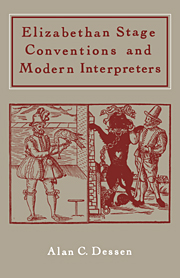Book contents
- Frontmatter
- Contents
- Preface
- Note on texts and old spelling
- 1 The arrow in Nessus: Elizabethan clues and modern detectives
- 2 Interpreting stage directions
- 3 The logic of ‘this’ on the open stage
- 4 Elizabethan darkness and modern lighting
- 5 The logic of ‘place’ and locale
- 6 The logic of stage violence
- 7 Theatrical metaphor: seeing and not-seeing
- 8 Conclusion: Elizabethan playscripts and modern interpreters
- Notes
- List of plays and editions
- Index
1 - The arrow in Nessus: Elizabethan clues and modern detectives
Published online by Cambridge University Press: 22 September 2009
- Frontmatter
- Contents
- Preface
- Note on texts and old spelling
- 1 The arrow in Nessus: Elizabethan clues and modern detectives
- 2 Interpreting stage directions
- 3 The logic of ‘this’ on the open stage
- 4 Elizabethan darkness and modern lighting
- 5 The logic of ‘place’ and locale
- 6 The logic of stage violence
- 7 Theatrical metaphor: seeing and not-seeing
- 8 Conclusion: Elizabethan playscripts and modern interpreters
- Notes
- List of plays and editions
- Index
Summary
Did you ever hear of a sleepwalker carrying a light?
Shakespeare's plays continue to fascinate – and puzzle – the modern reader. Actors, directors, editors, critics, and teachers all wrestle with the words that have come down to us in the quartos and the Folio, seeking clues to pluck out the heart of Hamlet's mystery or answer Lear's question: ‘Who is it that can tell me who I am?’ But anyone familiar with the wide range of interpreters and interpretations can attest that the solutions advanced or even the questions asked reveal as much about the modern detective as about the Elizabethan dramatist. Like Orlando bearing old Adam on his back, we too bring luggage with us to any reading of Elizabethan plays; or, to use Bernard Beckerman's image, when we pick up a book containing the printed words of a Shakespeare play we simultaneously put on a pair of spectacles ‘compacted of preconceptions about what constitutes drama and how it produces its effects.’ To the modern reader, the luggage or spectacles of an earlier age may appear ridiculous. Thus, we can chuckle at Nahum Tate's decision ‘to rectify what was wanting in the regularity and probability of the tale’ in King Lear by adding a love affair between Edgar and Cordelia and a happy ending, or we can look askance at Dryden's ‘improvement’ of Troilus and Cressida ‘to remove that heap of rubbish under which many excellent thoughts lay wholly buried.’
- Type
- Chapter
- Information
- Publisher: Cambridge University PressPrint publication year: 1984



